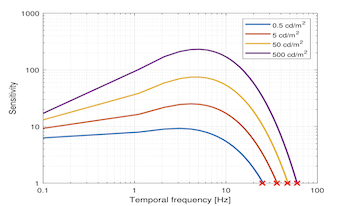
Contrast sensitivity functions (CSFs), which provide estimations of detection thresholds, have far-reaching applications in digital media processing, rendering, and transmission. There is a practical interest in obtaining accurate estimations of spatial and temporal resolution limits from a spatiotemporal CSF model. However, current spatiotemporal CSFs are inaccurate when predicting high-frequency limits such as critical flicker frequency (CFF). To address this problem, we modified two spatiotemporal CSFs, namely Barten’s CSF and stelaCSF, to better account for the contrast sensitivity at high temporal frequencies, both in the fovea and eccentricity. We trained these models using 15 datasets of spatial and temporal contrast sensitivity measurements from the literature. Our modifications account for two features observed in CFF measurement: the increase of CFF at medium eccentricities (of about 15 deg), and the saturation of CFF at high luminance values. As a result, the prediction errors for CFF obtained from the modified models improved remarkably.
Ali Bozorgian, Maliha Ashraf, Rafal Mantiuk, "Spatiotemporal contrast sensitivity functions: predictions for the critical flicker frequency" in Electronic Imaging, 2024, pp 209-1 - 209-8, https://doi.org/10.2352/EI.2024.36.11.HVEI-209
 Find this author on Google Scholar
Find this author on Google Scholar Find this author on PubMed
Find this author on PubMed